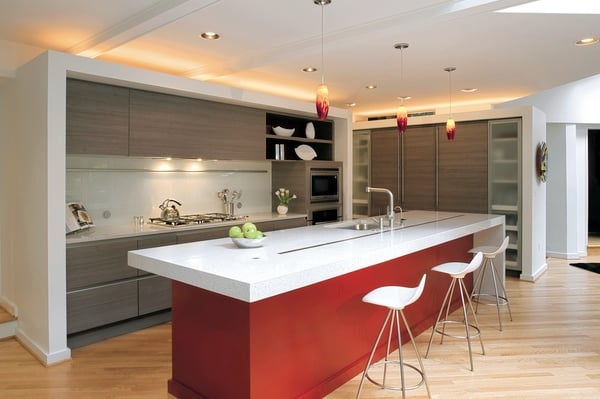This Bethesda kitchen by Anthony Wilder Design/Build features Silestone countertops. Their light, speckled color provides a contrast with the island’s red base. Photograph by Robert C. Lautman
If you’ve walked into a kitchen renovated in the past decade, chances are the countertops were shiny granite. But granite’s popularity may be waning.
“Many people are tired of polished granite countertops since we’ve been inundated with them,” says Jennifer Gilmer of Jennifer Gilmer Kitchen & Bath in Chevy Chase.
Homeowners are increasingly drawn to a more organic look. “The world is a very chaotic place, and people are always connected to an iPhone or iPad, so everything is about getting back to the earth,” says Stephanie Pritchard, a kitchen designer with Middleburg Design Company.
Designers say most of their clients are selecting countertops that fall into one of three categories: natural stone, engineered stone, and “green” options. Here’s a guide to what’s new and gaining popularity.
Natural Stone
Homeowners drawn to natural-stone countertops like the one-of-a-kind look. No two stone slabs have the same colors or veins running through them. And as the stone gets older, it can take on small cracks and chips that give it character and make it feel even more authentic. While granite is a type of natural stone, designers say homeowners are becoming more interested in alternatives.
Because of its clean, classic look, white Carrara marble is popular for traditional kitchens. “White marble used to be the smallest sector of our business compared to granite and quartz,” says Bob Blanchard of R. Bratti Associates, a stone-fabrication and countertop company in Alexandria. “Now it’s most of what we’re selling.”
Still, marble can be risky. “If you don’t take care of white marble, it stains over time,” says Leslie Roosevelt, an interior designer with Gilday Renovations in Silver Spring. And because it’s white, coffee-cup rings and red-wine spills show up more than they do on darker stones. Oil spots and minor scratches can also be a problem.
Many natural-stone counters are vulnerable to staining, and all require upkeep. “Natural stone can chip,” says Pritchard. “It veins. It etches. You have to seal it. You have to keep sealing it.”
Limestone, while offering a rustic look, isn’t impervious to wear. A limestone countertop overhang could crack off. Soapstone, a dark stone that looks like chalkboard (it’s the material used on high-school science-lab tables) is particularly beautiful–and particularly weak. “It’s very soft,” says Pritchard. “You can actually write your name in it with your fingernail.”
Despite the downsides of natural stone, Gilmer doesn’t shy away from using it in kitchens: “If you like the way it looks, that’s more important than stains from time to time.”
Engineered Stone
One of the more interesting developments in countertops is the increasing sophistication of engineered stone, a manmade composite of natural stone and other materials such as concrete and resin. The counters are designed to look like natural stone–without the maintenance worries.
“Manufacturers are constantly upgrading the look, whether it’s the size of the crystal or the color palette,” says Roosevelt. Quartz-composite options such as Silestone, Caesarstone, and Cambria are particularly popular.
Because quartz is one of the hardest materials–Blanchard calls it “bulletproof”–it’s largely indestructible. It doesn’t dull, and there’s not as much worry about chipping or etching. But Roosevelt says she wouldn’t put a hot pot on it–it might discolor. You can still do an undermount sink, popular in kitchens featuring natural stone, and add detailed edging just as you would with granite or limestone.
Gilmer encourages clients who want white Carrara marble to consider a quartz composite made to look like marble. Caesarstone calls its version Misty Carrera, and it looks so close to the real thing that there may be no reason to buy the marble at all.
Still, it can be hard to convince some people to go with engineered stone. There isn’t any natural veining, the colors don’t feel as authentic, and some think the stone looks processed. Says Blanchard: “It just doesn’t feel as real.”
“Green Countertops”
As eco-friendly living has become a priority for more homeowners, interest in countertops made from recycled materials has grown.
Concrete is popular, especially in modern kitchens. Because concrete countertops are handmade by artisans, some people think of them as sculptural pieces. You can dye a concrete countertop to look like natural stone, or you can inset items in it, making it a good choice for those who want a more custom look. Some mix in flecks of glass or unusual objects such as seashells.
There are downsides. “If concrete counters are not 100 percent level, they can crack,” says Pritchard. Installation can also be expensive; the installer needs to build a form, which requires expert carpentry, before pouring, finishing, and curing the concrete.
Concrete is also not immune from staining and everyday wear and tear. Although it’s sealed to prevent food or stains from seeping in, the countertop will likely develop small cracks or fissures with time.
Another green choice is glass. While designers are big advocates of glass-tile backsplashes, they’re torn when it comes to glass countertops. Roosevelt likes them and has them in her own home. “They provide an unexpected bright spot in an interior,” she says. But she warns that glass isn’t for everyone.
The disadvantage? “Scratches, scratches, scratches,” she says. Plus, glass countertops show everything–dust, cooking grease, crumbs.
If you have your heart set on glass, Pritchard suggests adding a glass counter to a breakfast bar or a kitchen island, just not making it the bulk of the countertop: “It’s much too fragile.”
Products such as IceStone, Vetrazzo, and EnviroGlas may be good alternatives to glass panels. All three mix recycled glass with cement, concrete, or resin. EnviroGlas and Vetrazzo actually uses glass chips from discarded bottles and windows to create a stone-like counter in a variety of colors.
Among the newest green options are recycled-paper countertops such as PaperStone or Richlite. Made to look like concrete or stone, these are made of recycled cardboard and polymers. “It’s an interesting concept, an interesting look,” says Roosevelt. But for many designers, the jury is still out.
Shannon Kadwell of Anthony Wilder Design/Build in Cabin John says clients get excited about recycled-paper countertops–until they hear the price. They can be even more expensive than natural stone.
Regardless of budget, keep in mind that a countertop should tie a kitchen together, not define it. Be sure to choose textures and tones that take a back seat to your cabinetry and appliances, and pick a countertop material that’s as functional as it is stylish.
And if you still love glossy granite, go for it. Says Roosevelt: “For some, granite is here to stay. People who haven’t had it still want it.”
Counter Options
While many natural-stone countertops are beautiful, they can stain or chip easily. Here are some alternatives.
If you like: Elegant and classic Italian Carrara marble but don’t want to worry about staining . . .
Consider: Caesarstone in Misty Carrera. It looks almost the same as the real thing and is nearly impervious to stains, chips, and scratches.
If you like: The chalkboard-like quality of soapstone but don’t want to put this super-soft rock on your counters . . .
Consider: Honed Absolute Black granite. It’s more scratch-resistant and still jet-black, but it looks more granular. Another option, Stephanie Pritchard of Middleburg Design Company suggests, is Pietra Cardosa limestone; she says it’s a little more durable than soapstone and looks nearly identical.
If you like: Glass countertops but don’t want to worry about cracking the material if you drop a cast-iron skillet on it . . .
Consider: Recycled-glass countertops. You’ll still get the reflective, bright quality of glass, but they’re much more durable.
If you like: The strength of granite countertops but are tired of a glossy finish . . .
Consider: Honed granite. The matte finish will give your kitchen a less polished look. While honing can make granite more vulnerable to staining, it’s still stronger than marble and limestone.
This article appears in the October 2011 issue of The Washingtonian.


















